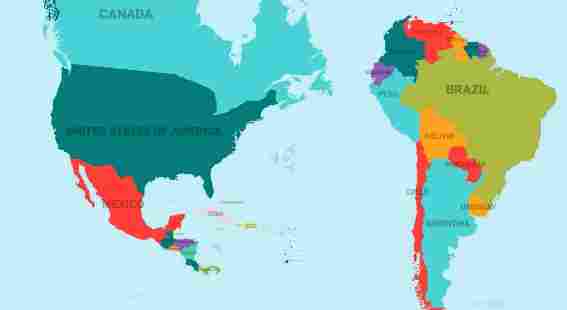The Americas, a vast and diverse landmass, are divided into two major parts – North America and South America. Despite their geographical proximity, these continents showcase distinct characteristics in terms of culture, history, geography, and more. This exploration aims to dissect the nuanced differences between North America and South America, shedding light on their unique identities.
Geography: The Lay of the Land
1.1 North America
North America is the third-largest continent on Earth, comprising countries such as the United States, Canada, Mexico, and others. Its geographical features include the Rocky Mountains, the Great Plains, and the vast Mississippi River system. The Arctic Circle encompasses parts of North America, contributing to its diverse climate.
1.2 South America
In contrast, South America is the fourth-largest continent, known for its stunning Amazon Rainforest, the Andes mountain range, and the expansive Amazon River. The continent is characterized by its tropical rainforests, diverse ecosystems, and the iconic Galápagos Islands.
Climate Variations
2.1 North America
North America experiences diverse climates, ranging from the Arctic conditions in Canada to the tropical climate of Florida. The continent witnesses seasons such as harsh winters in the northern regions, contrasting with the warm summers in the southern parts.
2.2 South America
South America, located primarily in the southern hemisphere, showcases a broader range of climates. From the tropical rainforests near the equator to the temperate conditions in the southern cone, the continent offers a spectrum of climates, each influencing the local flora and fauna.
Cultural Mosaic: People and Languages
3.1 North America
North America is a melting pot of cultures and ethnicities. The United States alone is a tapestry of diverse communities, shaped by immigration from various parts of the world. English is the predominant language, but Spanish, French, and numerous indigenous languages are spoken across the continent.
3.2 South America
South America, too, boasts a rich cultural tapestry, heavily influenced by indigenous heritage and the legacies of colonialism. Spanish and Portuguese are the dominant languages, with a significant portion of the population speaking indigenous languages. Countries like Brazil have a unique cultural fusion due to a historical blend of indigenous, African, and European influences.
Historical Significance
4.1 North America
North America’s history is shaped by indigenous civilizations, European colonization, and the quest for independence. The United States, in particular, played a pivotal role in the global events of the 20th century, from World Wars to the Cold War, influencing geopolitics and global dynamics.
4.2 South America
South America, too, has a rich historical narrative. The Inca and Aztec civilizations thrived in the region long before the arrival of Europeans. The continent witnessed the conquests of Spanish and Portuguese explorers, leading to the establishment of colonies that played crucial roles in the global trade network.
Economic Contrasts
5.1 North America
North America boasts some of the world’s largest economies, with the United States, Canada, and Mexico being key players. The region is characterized by industrialization, technological advancements, and a diversified economy encompassing sectors like finance, technology, and manufacturing.
5.2 South America
South America exhibits economic diversity, with countries like Brazil having robust economies, while others face challenges. The continent is renowned for its natural resources, including vast agricultural lands, minerals, and the Amazon Rainforest, contributing to the global economy.
Biodiversity and Natural Wonders
6.1 North America
North America is home to diverse ecosystems, from the Arctic tundra to the Sonoran Desert. Yellowstone National Park, with its geothermal wonders, and the Great Barrier Reef in Australia, are among the notable natural attractions.
6.2 South America
South America, however, stands out for its unparalleled biodiversity. The Amazon Rainforest, often referred to as the “Lungs of the Earth,” is the largest rainforest globally, teeming with a staggering array of flora and fauna. The Galápagos Islands, with their unique wildlife, further contribute to the continent’s natural marvels.
Links to Related Information
For a deeper dive into the specifics of North America and South America, consider exploring the following Wikipedia pages:
Conclusion
In the intricate tapestry of our planet, North America and South America emerge as distinct canvases, each painted with its unique hues of geography, culture, history, and natural wonders. From the bustling cities of North America to the biodiversity-rich landscapes of South America, these continents offer a rich tapestry of experiences.
Navigating the differences between North America and South America unveils not only the geographical disparities but also the vibrant stories of the people who call these continents home. As we traverse the hemispheres, it becomes evident that appreciating the uniqueness of each continent enriches our global perspective and fosters a deeper understanding of the multifaceted world we inhabit.
Contents
- 1 Geography: The Lay of the Land
- 2 1.1 North America
- 3 1.2 South America
- 4 Climate Variations
- 5 2.1 North America
- 6 2.2 South America
- 7 Cultural Mosaic: People and Languages
- 8 3.1 North America
- 9 3.2 South America
- 10 Historical Significance
- 11 4.1 North America
- 12 4.2 South America
- 13 Economic Contrasts
- 14 5.1 North America
- 15 5.2 South America
- 16 Biodiversity and Natural Wonders
- 17 6.1 North America
- 18 6.2 South America
- 19 Links to Related Information
- 20 Conclusion

















